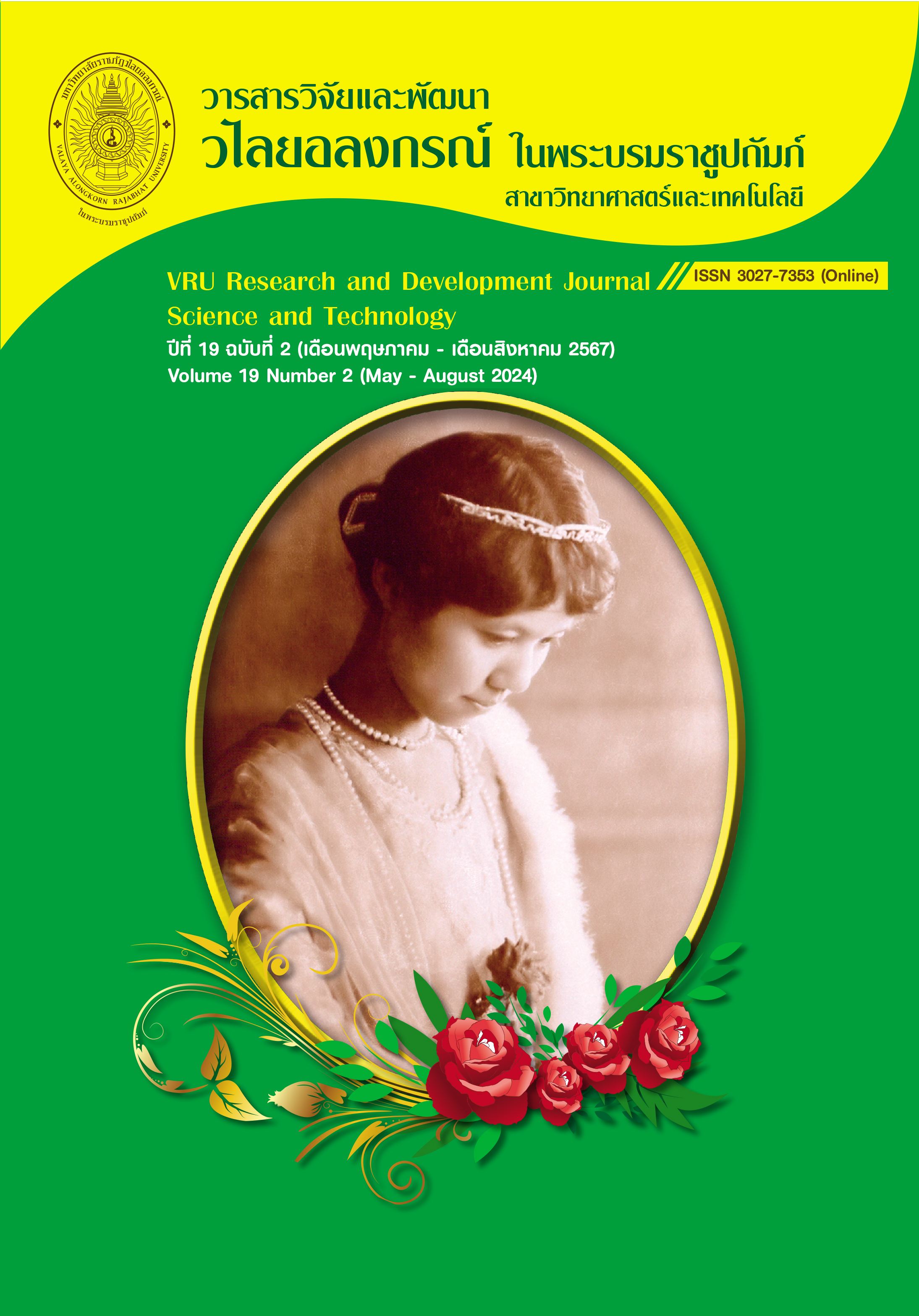CYTOTOXICITY OF ALPINIA GALANGA RHIZOME EXTRACTS AND ISOLATED COMPOUNDS AGAINST SMALL CELL LUNG CANCER NCI-H187 CELL LINE
Main Article Content
Abstract
The purpose of this research was to study the cytotoxicity of the extracts from Alpinia galanga rhizome and isolated compounds against NCI-H187 small cell lung cancer cells.
1'S-1'-acetocavical acetate (1), p-coumaryl diacetate (2), 1'S-1'-acetoxy-eugenol acetate (3), (S)-hydroxycavicol acetate (4), 4-hydroxycinnamaldehyde (5) and trans-p-acetoxycinnamyl alcohol (6) were isolated from the rhizomes of Alpinia galangal. The structures of the isolated compounds were characterized by spectroscopic techniques and comparison with the literature. Among them, the extracts, and compounds 1-5 displayed potent cytotoxic activity against human small cell lung cancer (NCI-H187) cells exhibiting >98% at the highest concentration
(50 μg). Compound 1 showed the highest cytotoxicity against NCI-H187 cells with 99.69% inhibition and IC50 of 4.61 μM, 1.68-fold higher than ellipticine.
Downloads
Article Details
Copyright Notice
The copyright of research articles published in the VRU Research and Development Journal Science and Technology Journal belongs to the Research and Development Institute, Valaya Alongkorn Rajabhat University under the Royal Patronage. Reproduction of the content, in whole or in part, is prohibited without prior written permission from the university.
Responsibility
The content published in the VRU Research and Development Journal Science and Technology Journal is the sole responsibility of the author(s). The journal does not assume responsibility for errors arising from the printing process.
References
Anirban, C., & Santanu, P. (2018). A Review on Phytochemical and Pharmacological Potential of Alpinia galanga. Pharmacognosy Journal, 10(1), 9-15.
Datta, R., Kaur, A., Saraf, I., Singh, I. P., & Kaur, S. (2019). Effect of crude extracts and purified compounds of Alpinia galangal on nutritional physiology of a polyphagous lepideopteran pest, Spodoptera litura (Fabricus). Ecotoxicology and environmental Safety, 168, 324-329.
Ghosh, B., Saha, K., Ghosh, A., & Dhar, S. (2008). Cardiovascular Evaluation in Patients with
Systemic Lupus Erythematosus-a Cross Sectional Study. Chronicles of Young Scientists, 2(3), 139-143.
Itokawa, H., Watanabe, K., Mihashi, S., & Iitaka, Y. (1980). Isolation of Agarofuran-Type Sesquiterpenes from Alpinia japonica (Thunb.) Miq. Chemical and Pharmaceutical Bulletin, 28(2), 681-682.
Janssen, A.M., & Scheffer, J.J. (1985). Acetoxychavicol Acetate, an Antifungal Component of Alpinia galanga. Planta Med, 51(6), 507-511.
Lo, C.Y., Liu, P.L., Lin, L.C., Chen, Y.T., Hseu Y.C., Wen Z.H., & Wang H.M. (2013). Antimelanoma and Antityrosinase from Alpinia galangal Constituents. The Scientific World Journal, 2013(3), 186505.
Ma, X.N., Xie, C.L., Miao, Z., Yang, Q., & Yang X.W. (2017). An Overview of Chemical Constituents from Alpinia Species in the Last Six Decades. RSC Advances, 7(23), 14114-14144.
Matsuda, H., Morikawa, T., Managi, H., & Yoshikawa, M. (2003). Antiallergic Principles from Alpinia galanga: Structural Requirements of Phenylpropanoids for Inhibition of Degranulation and Release of Tnf-α and Il-4 in Rbl-2h3 Cells. Bioorganic & Medicinal Chemistry Letters, 13(19), 3197-3202.
Morita, H., & Itokawa, H. (1988). Cytotoxic and Antifungal Diterpenes from the Seeds of Alpinia galanga. Planta Med, 54(02), 117-120.
Morikawa, T., Ando, S., Matsuda, H., Kataoka, S., Muraoka, O., & Yoshikawa M. (2005). Inhibitors of Nitric Oxide Production from the Rhizomes of Alpinia galanga: Structures of New 8-9’ Linked Neolignans and Sesquineolignan. Chemical and Pharmaceutical Bulletin, 53(6), 625-630.
Niyomkam, P., Kaewbumrung, S., Kaewnpparat, S., & Panichayupakaranant, P. (2010). Antibacterial Activity of Thai Herbal Extracts on Acne Involved Microorganism. Pharmaceutical Biology. 48(4), 375-380.
Noro, T., Sekiya, T., Katoh, M., Oda, Y., Miyase, T., Kuroyanagi, M., Ueno, A., & Fukushima, S. (1988). Inhibitors of Xanthine Oxidase from Alpinia galanga. Chemical & Pharmaceutical Bulletin, 36(1), 244-248.
O’Brien, J., Wilson, I., Orton, T., & Pognan, F. (2000). Investigation of the Alamar Blue (resazurin) fluorescent dye for the assessment of mammalian cell cytotoxicity. Eur. J. Biochem, 267(17), 5421–5426.
Sivasothy, Y., Ibrahim, H., Paliany, A.S., Alias, S.A., Md Nor, N.R., & Awang, K. (2013). A New Bis-Labdanic Diterpene from the Rhizomes of Alpinia pahangensis. Planta Med, 79(18), 1775-1780.
Stange, R.R.Jr., Sims, J.J., Midland, S.L., & McDonald, R.E. (1999). Isolation of a Phytoalexin, trans-p-Coumaryl Aldehyde, from Cucurbita maxima, Cucurbitaceae. Phytochemistry, 52(1), 41-43.
Wong, L.F., Lim, Y.Y., & Omar, M. (2009). Antioxidant and Antimicrobial Activities of Some Alpinia Species. Journal of Food Biochemistry, 33(6), 835-851.
Xu, J.J., Zeng G.Z., Yang S.C., Shen Y., & Tan N.H. (2013). 8-9’ Linked Neolignans with Cytotoxicity from Alpinia conchigera. Fitoterapia, 91, 82-86.
Ye, Y., & Li, B. (2006). 1’S-1’-Acetoxychavicol Acetate Isolated from Alpinia galanga Inhibits Human Immunodeficiency Virus Type 1 Replication by Blocking Rev Transport. Journal of General Virology, 87(7), 2047-2053.
Zeng, Q.H., Lu, C.L., Zhang, X.W., & Jiang, J.G. (2015). Isolation and Identification of Ingredients Inducing Cancer Cell Death from the Seeds of Alpinia galanga, a Chinese Spice. Food & Function, 6(2), 431-443.
Zhu, Y., Regner, M., Lu, F., Kim, H., Mohammadi, A., Pearson, T.J., & Ralph, J. (2013). Preparation of Monolignol γ-Acetate, γ-p-Hydroxycinnamate, and γ-p-Hydroxybenzoate Conjugates: Selective Deacylation of Phenolic Acetates with Hydrazine Acetate. RSC Advances, 3(44), 21964-21971.


